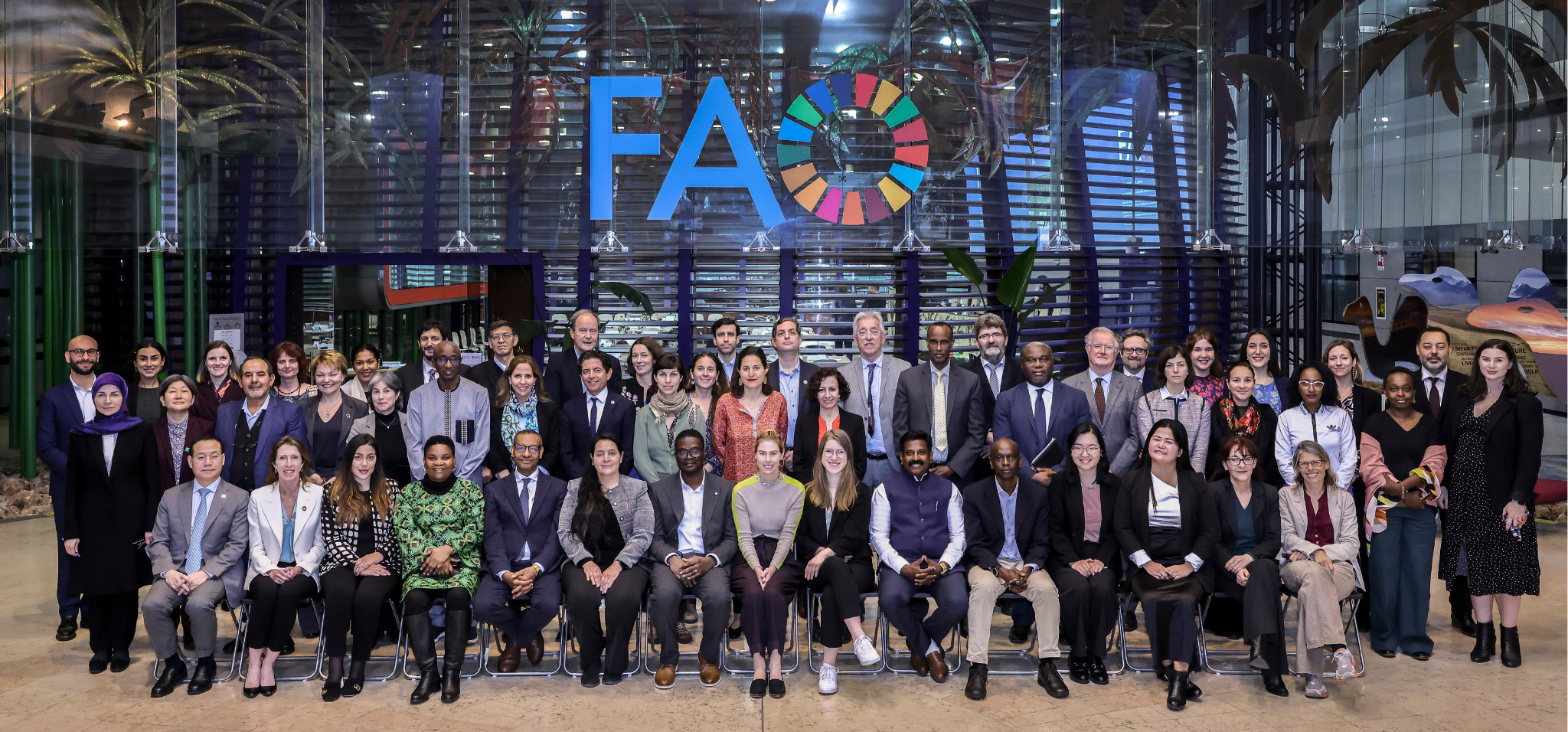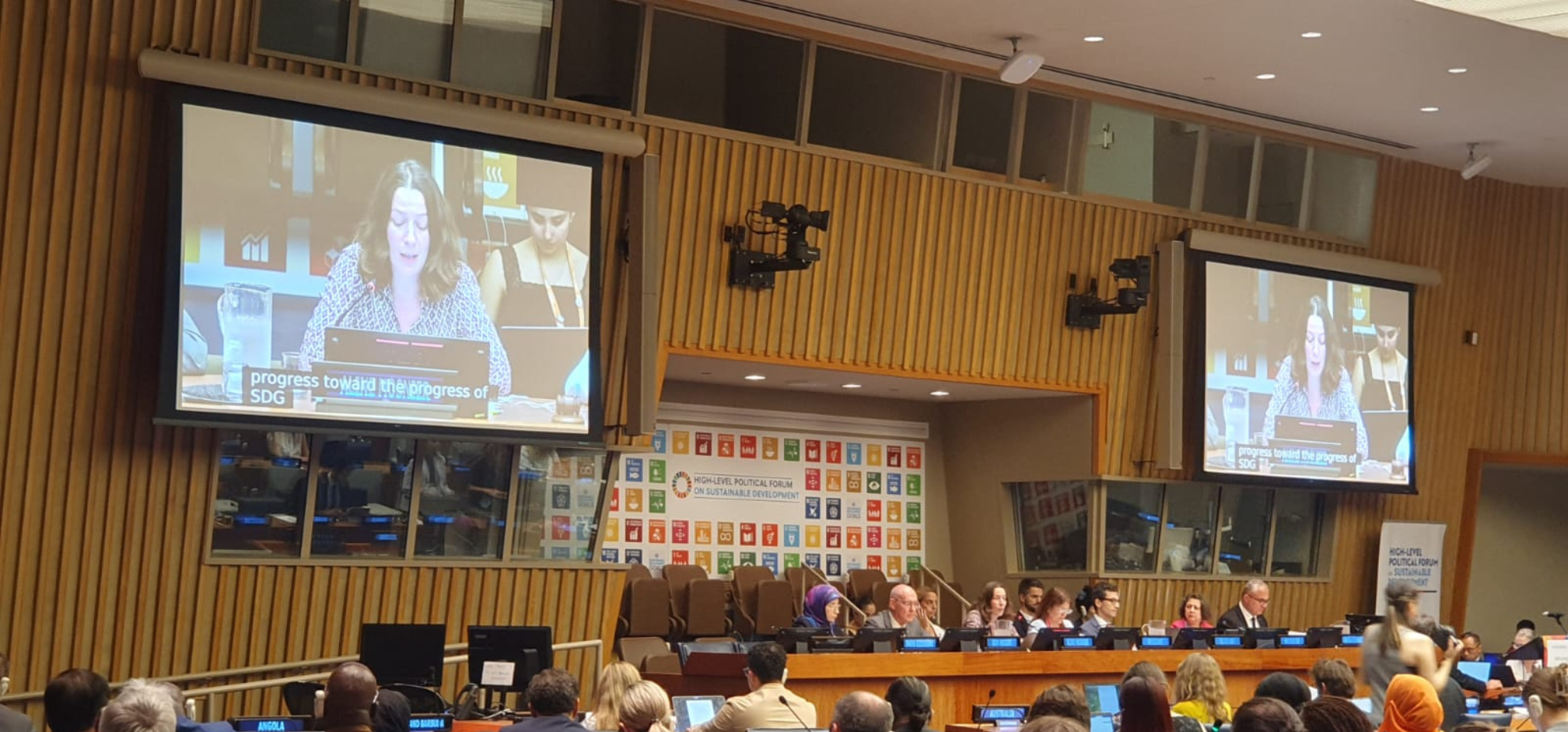
Experts gathered at the EGM on SDG 2 at the FAO. Credit: ©FAO/Alessandra Benedetti. Editorial use only. Copyright ©FAO.
TweetAuthor: Aline Mosnie, FABLE Scientific Director.
How does the HLPF work?
The HLPF focuses on the follow-up and review of the implementation of the 2030 Agenda for Sustainable Development by all UN Member States as well as representatives from civil society organizations. HLPF 2024 conducted an in-depth review of SDG 1 (no poverty), SDG 2 (zero hunger), SDG 13 (climate action), SDG 16 (peace, justice, and strong institutions), and SDG 17 (partnerships for the Goals) in times of multiple ongoing crises.
For each of these SDGs under review, preliminary meetings gathering experts from all sectors and countries have been organized. In March 2024, with more than 50 experts representing government institutions, the United Nations, non-governmental and civil society organizations, the private sector, and research, I participated in the Expert Group Meeting (EGM) to prepare the HLPF review of SDG 2. The recommendations of the experts gathered in Rome can be found in the report Expert Group Meeting on Sustainable Development Goal 2 and its interlinkages with other SDGs.
HLPF 2024 was organized under the auspices of the Economic and Social Council (ECOSOC). The first week focused on the review of the SDGs, and the second week hosted the three-day ministerial segment including the voluntary national reviews (VNRs) of the implementation of the 2030 Agenda by 36 countries. In parallel with the official program, many side events were organized by the UN and civil society organizations.

The UN conference room where the SDG review took place with the panel (left), member states representatives (right) civil society organizations representatives, and observers (front). Credit: Aline Mosnier.
It was my first participation in the HLPF. I was a panelist at the session on SDG 2 and interlinkages with other SDGs. Facing all UN member states’ representatives was impressive. During this 3-hour session, the state of SDG 2 in the world was briefly presented and each panelist could share views on challenges and solutions to meet SDG 2. The UN member states representatives reflected on the state of SDG 2 in their country and in the world. Every intervention was limited to 3 minutes. The next day, I also participated in a side event organized by the FAO, UNDESA, and the European Commission on Uniting Forces for Integrating Science, Policy, and Society to Achieve Zero Hunger”.
What is the state of SDG 2?
SDG 2 is about ending hunger, achieving food security and improved nutrition, and promoting sustainable agriculture. It is at the core of the food systems transformation agenda, as well as at the core of the whole 2030 Agenda as it connects to all other SDGs. SDG 2 is particularly connected to the achievement of good health (SDG 3) through diets and environmental sustainability through agriculture (SDGs 3, 15).
In 2022, there were still 783 million people who faced chronic hunger worldwide and approximately 30% of the world’s population did not have regular access to adequate food during the year, which is a backslide compared to 2019. The 3 Cs – the COVID-19 pandemic, the increased number of conflicts, and weather extremes due to climate change, have largely contributed to this deterioration. More generally, the different shocks the world has experienced over the last years have been mutually reinforcing to make the Sustainable Development Goal (SDG) 2 off-track.
Obesity is on the rise everywhere, but micronutrient deficiencies can still co-exist within the same individuals due to poor diets. According to the FAO State of Food and Agriculture (SOFA) report 2023, non-communicable diseases from unhealthy diets lead to about 7 percent of global GDP.
Interventions at the HLPF SDG 2 review
Conflicts took a prominent role in the discussions at the EGM and the HLPF. Conflict remains the most significant driver of acute food insecurity in conflict areas, and it also undermines progress toward the achievement of SDG2 in countries outside the conflict zone through displacement of refugees, trade disruptions, and reallocation of budgets towards defense. I took advantage of being at the heart of the United Nations to insist on the crucial role of diplomacy to avoid and resolve conflicts.

The panel at the SDG2 review during my intervention. Credit: Natalia Galat.
Several countries, and more particularly Ireland, raised the need for an immediate ceasefire in Gaza, where the population is at risk of famine, and condemned the weaponization of food in this conflict. Ukraine, a few European countries, and the USA highlighted the destabilizing impacts of the invasion of Ukraine by Russia on the world’s food prices, while Russia and China emphasized the need to remove unfair restrictions on trade.
The need to adopt healthier diets with co-benefits for the planet has also been emphasized. During the HLPF 2024 session on SDG2, the representative of Switzerland advocated for the use of an indicator of the quality of diets in SDG2.
Anticipatory action, early warning systems, and social protection serve as crucial initial safeguards for protecting lives, ensuring food security, and maintaining social cohesion despite shocks. Several member states’ representatives have highlighted their actions in this direction, e.g., free school meals in Brazil and Finland, universal social protection in Morocco, and a food stamp system in the Philippines. Malawi and Zambia’s representatives emphasized the challenges of tackling the large agricultural production losses they recently experienced due to climate shocks.
What is the role of FABLE?
Highlight the connections of SDG2 with the other SDGs: Tremendous progress has been achieved in agriculture to feed the growing world population, but agriculture has also been the major driver of the conversion of natural ecosystems and the loss of biodiversity and food systems are responsible for about a third of the total GHG emissions. When we look simultaneously at the achievement of multiple objectives it might be harder to find solutions, but it is needed to avoid or mitigate negative trade-offs of decisions taken in silo.
Foster collaboration across countries: FABLE is a network of interdisciplinary scientists who try to build food and land pathways that can meet national objectives without exceeding planetary boundaries. Our approach acknowledges the diversity of contexts and the right of people to decide for themselves but also highlights the need for joint efforts to secure the livelihoods of young and future generations.
Connecting science with society: By leveraging accurate data and clear indicators, scientific evidence can be used to define a “safe operating space” for society. Our open-access tools facilitate collaboration between scientists and policy makers, ensuring that scientific insights can be integrated into practical solutions. Broadening stakeholder participation is essential to avoid societal polarization, to address the needs of those impacted by reforms, and to foster collective creativity and resilience in the face of complex challenges and higher uncertainty.
The Summit of the Future
Watch out for the Summit of the Future that will take place in September at the United Nations in New York. The Pact of the Future which is currently under negotiations and revisions will be adopted by world leaders “to forge a new international consensus on how we deliver a better present and safeguard the future”